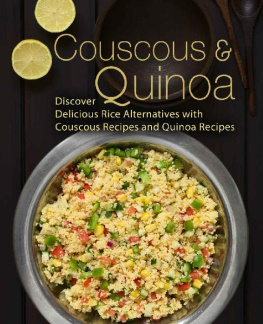Introduction
What are supergrains?
In todays society, the impact food can have on our health is becoming increasingly important. A superfood is a food that by nature is nutrient dense compared to its energy value. Supergrains are grains that are not only packed with nutrients, but have also been linked to many health benefits, which is why they are currently gaining worldwide interest.
Lets start by defining grains. These are the seeds of certain plants, where the hard inedible husk or outer layer is removed, leaving the edible grain (or berry). Unrefined (whole) grains contain all three parts of the grain: the bran, germ and endosperm. Supergrains (in their simplest forms) are all unrefined grains. Refined grains have the bran and germ removed, leaving just the endosperm which contains the least vitamins and minerals.
This book explores 12 supergrains: quinoa, amaranth, buckwheat, brown rice, chia, millet, oats, spelt, kamut, barley, farro and freekeh. We look at their history, nutritive and health benefits, what they are best used for and how to cook them. There are delicious recipes for each supergrain so you will have the confidence to incorporate them into your everyday life.
Although some of the supergrains are quite common, others you may not have heard of, despite the fact that they have been around for centuries. Spelt, for instance, was a staple grain in ancient civilisations such as Greece and Rome. One of the main reasons for their decline in popularity was the modernisation of farming methods, which produced more refined, highly processed foods. Compared to these new, refined foods, supergrains came to be considered by many cultures as peasant food, only eaten by the very poor or even fed to the animals.
The problem with replacing supergrains with refined grains, however, is that the latter are much lower in nutrients, healthy fats, antioxidants and phytonutrients. Although most of the grains currently consumed in first-world countries are highly refined, such as white rice, white wheat flour and ground cornmeal, there is renewed interest in supergrains for their health benefits, superior taste and suitability for restricted diets, such as gluten and wheat intolerances, vegetarians and vegans.
Another reason for the re-emergence of supergrains is a growing interest in making food more simplistic, by going back to its original source and subjecting it to minimal refining. Farmers markets, the organic and biodynamic food movements, the demand for quality ingredients and the move towards whole foods all indicate an increasing awareness and interest in what goes into food products and their natural health benefits.
As supergrains gain in popularity, their availability also improves. Quinoa, for example, was once considered a speciality grain, only found in serious health food stores and on restaurant menus, but today it can be found in almost every major supermarket. Kamut and spelt are enjoying a renewed popularity, too, especially in the form of baked products such as bread. Chia is also receiving a lot of attention as it contains more omega 3 and dietary fibre than any other natural food.
The recipes in this book reflect my approach to health and eating everything in moderation, with a focus on whole foods, such as supergrains. Eating responsible portion sizes means that occasional treats can be enjoyed (and, in fact, are a must!). Meals should be balanced, with one portion of protein, one portion of complex carbohydrate and two to three serves of vegetables. I hope these delicious recipes inspire you and contribute to your own healthy eating.
Health benefits
Controlling blood sugar levels
The glycaemic index (GI) is a measure of the speed with which individual carbohydrate foods are converted into blood sugar. The lower the GI of a food, the slower it releases glucose, resulting in sustained energy. High-GI foods, on the contrary, release glucose quickly and give a spike in blood sugar. As supergrains are complex carbohydrates, they generally have a low GI, providing slowly released energy that is extremely beneficial for everyone, particularly those with diabetes.
High fibre
Supergrains are an excellent source of dietary fibre, whether soluble, insoluble or both. Soluble fibre is water soluble, as the name suggests, and forms a thick gel-like substance. This gel helps keep the bowel healthy, reduces blood cholesterol and slows the release of sugars in the blood, which is very useful for those with diabetes. Insoluble fibre, on the other hand, stays intact even when in contact with water. Insoluble fibre helps in preventing constipation and irritable bowel syndrome, keeps your colon healthy and assists with heart health.
Reduced risk of obesity/weight management
Studies are beginning to show that supergrains can play an important role in reducing the risk of obesity when they are used as a tool for weight control. They are higher in fibre than highly processed grains, especially soluble fibre which can increase satiety so you feel full for longer and therefore eat less overall.
Prebiotic effect
Prebiotics are foods that stimulate the growth of healthy bacteria, helping to produce digestive enzymes. There have been recent studies on the prebiotic effects that supergrains can have in the digestive system, mainly due to the fermentation of the soluble fibre they contain.
Reduced risk of cardiovascular disease
The relationship between the consumption of supergrains and the reduced risk of cardiovascular disease is of great interest. Supergrains that are high in soluble fibre (such as oats and barley) have been proven to be effective in reducing blood cholesterol. Supergrains are also associated with a reduced risk of stroke, healthier carotid arteries and reduced blood pressure.
Reduced risk of certain cancers
Supergrains contain many natural compounds that protect cells from damage and therefore may reduce the risk of certain cancers. Insoluble fibre, in particular, is thought to reduce the risk of colon cancer by maintaining a healthy colon. Other compounds to be of benefit include antioxidants, phenols, lignans and saponins.
























